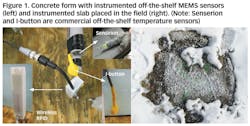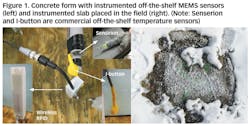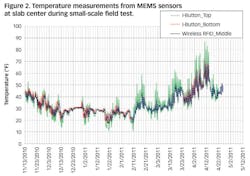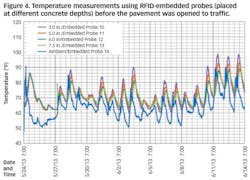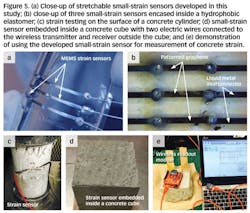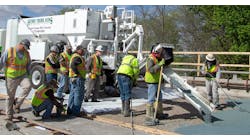By: Halil Ceylan, Ph.D., Liang Dong, Ph.D., Yueyi Jiao, Seval Yavas, Shuo Yang, Sunghwan Kim, Ph.D., P.E., Peter Taylor, Ph.D., P.E., and Kasthurirangan Gopalakrishnan, Ph.D.
Pavements tend to deteriorate over time under repeated traffic loads and/or certain environmental conditions.
By detecting pavement distresses and damage early enough, it is possible for transportation agencies to develop more effective pavement maintenance and rehabilitation programs and thereby save time and money. To detect and monitor data related to pavement distresses in concrete pavements, researchers at Iowa State University’s National Concrete Pavement Technology Center (ISU/CP Tech Center) are investigating the use of wireless, microfabricated sensor systems.
Structural health monitoring (SHM) is a systematic method for assessing the structural state of pavement infrastructure systems and documenting their condition. Over the past several years, SHM has traditionally been accomplished through the use of wired sensors embedded in bridge and highway pavement systems. However, the use of wired sensors has limitations for long-term SHM and presents other associated cost and safety concerns.
Recent achievements in micro-electromechanical sensors and systems (MEMS) and nano-electromechanical sensors and systems (NEMS) technology make it possible to manufacture sensors using microfabrication techniques. This kind of advanced/smart-sensing technology, including wireless sensors, shows vast potential for improving the traditional SHM approach. The ISU/CP Tech Center research team has been investigating MEMS-type devices and their suitability for pavement health-monitoring applications. Specific projects have been sponsored by the Iowa Highway Research Board (TR-575, TR-637).
Taking Ames
First, the research team (led by Dr. Halil Ceylan) conducted a feasibility study. A commercially available wireless concrete monitoring system, based on radio-frequency identification (RFID) technology (see Figure 1), was tested under controlled laboratory and field conditions.
The test results (see Figure 2) validated the ability of the RFID wireless concrete monitoring system to accurately measure the concrete’s temperature both inside the laboratory and in the field under severe weather conditions.
Based on the successful outcome of the feasibility study, a follow-up project was initiated, with two primary objectives:
- Deploy some of the promising commercial off-the-shelf (COTS) MEMS sensors developed for monitoring concrete pavement in a live field project; and
- Develop a wireless MEMS capable of real-time, remote monitoring of strain, moisture content and temperature in concrete pavement
Use of COTS MEMS sensors for concrete pavement field monitoring
Thirty sensors, including 14 RFID temperature tags (nine extended probes and five embedded probes), four MEMS digital moisture sensors, five iButtons, and seven longitudinal strain gages were installed in a new concrete pavement project on U.S. 30 near Ames, Iowa.
The embedded temperature and strain sensors were able to capture data related to slab curling and warping behavior. As shown in Figure 3, at 2 a.m. on June 8 (when the concrete curled up), the top of the concrete slab measured a maximum of 200 tensile microstrain (as indicated by strain gage No. 6), and the bottom of the concrete slab measured a maximum of 200 compressive microstrain (as indicated by strain gage No. 3).
During the same time period, as shown in Figure 4, the top of the concrete measured an approximate temperature of 60˚F and the bottom concrete was 65˚F. Because the top of the concrete was cooler than the bottom, the slab curled up. This curling behavior is consistent with the strain readings during the same time period shown in Figure 3.
Although several sensors malfunctioned after road construction, the 81% sensor survival rate at the beginning of opening to traffic could still be regarded as successful instrumentation in comparison to previous pavement instrumentation studies. Furthermore, by using MEMS sensors, concrete maturity could be directly calculated on site and immediately generated as one of the sensor system outputs.
However, the performance of the off-the-shelf MEMS sensors deployed on U.S. 30 illuminated current limitations—i.e., packaging, wires, signal strength, etc.—when used in field pavement health-monitoring systems. To overcome these issues associated with long-term operations, a ZigBee protocol-based wireless communication system was implemented for the MEMS sensors.
Wireless MEMS sensors for pavement health monitoring
In this phase of the study, multiple types of sensors were developed, tested and demonstrated in the laboratory, and some were installed in concrete/mortar for trial applications. The moisture content sensor and the temperature sensor were combined to achieve simultaneous multifunctional sensing. Moreover, a graphene-based strain sensor was installed in a concrete cylinder for real-time loading testing.
The following types of MEMS sensors were developed in-house during this study:
- The nanofiber-based moisture sensor was constructed using poly (methyl methacrylate) (PMMA) nanofibers to fabricate a planar capacitive moisture sensor that has a quick response time;
- The graphene oxide-based moisture sensor was constructed using the simple fabrication method of forming large-area graphene oxide (GO) thin films;
- The flexible graphene strain sensor took advantage of the high piezoresistance of graphene and the flexibility of liquid metal and polydimethylsiloxane (PDMS) to achieve full sensor flexibility;
- The graphene-based strain sensor and the graphene-based pressure sensor were fabricated by applying patterned graphene to Scotch tape and then transferring the patterned graphene to another adhesive tape, which made both sensors capable of application to any flexible object;
- The microfluidic-patterned 3-D graphene sensor overcame limitations related to the complexity of fabricating patterned graphene film and did so at a low cost; and
- The different sizes of MEMS-based temperature sensors developed in this research can be used either as single sensors or as part of a multifunctional sensor system. The temperature and water content sensor uses a straightforward structure to simplify the fabrication process and retain a good sensor response while lowering the cost.
The unidirectional graphene strain sensor also was used to evaluate the strain characteristics of a concrete cylinder undergoing compression. The sensor was conformably attached onto the curved surface of the concrete cylinder (diameter: 101 mm; height: 203 mm) using liquid Super Glue, as shown in Figure 5(c); this was only possible because of the sensor’s high structural flexibility. In addition, a commercial extensometer was mounted on the same cylinder for calibration. A load was vertically applied to the top surface of the cylinder, and the time-varying resistance values from both the graphene sensor and extensometer were recorded. As the applied load increased to 30 kilopounds (kip), the concrete cylinder was compressed in the longitudinal direction but expanded radially, thus stretching the attached sensor.
A special aid
MEMS represent an innovative solution in infrastructure condition monitoring that can be used to wirelessly detect and monitor the initiation and growth of structural and material durability-related damage in concrete structures. Wireless sensors can save both installation time and cost, and do not present wire damage concerns.
A set of MEMS, along with the wireless signal transmission system developed in this research, can potentially aid transportation agencies in implementing reliable, real-time and continuous health-monitoring systems for transportation infrastructure. Such health-monitoring systems will support decision-making about appropriate maintenance and repair activities and timing, thus helping to ensure that infrastructure systems perform optimally during their service lives.
Suggestions for future research include the following:
- Development of an array of flexible and even wearable strain sensors for monitoring 3-D distribution of pavement strains with a high spatiotemporal resolution;
- Investigation of a more effective assembly method to allow the developed sensing elements to be integrated into a single package for convenient installation and data readout, which may require, to some extent, involvement of the semiconductor and MEMS packaging industries; and
- Expansion of findings and accomplishments related to infrastructure health monitoring studies described herein into other areas of transportation infrastructure systems, such as:
- Flexible and composite pavement systems;
- Geo-foundation systems;
- Bridge structures and systems;
- Mass concrete applications;
- Construction quality control and quality assurance;
- Construction management;
- Critical infrastructure condition monitoring and pre-alert systems;
- Monitoring of viaducts, drainage and water channels;
- Applications in unpaved and low-volume county and city roads, such as determining freezing and thawing cycles and thawing periods using sensor systems, spring load restriction (SLR) guidance based on sensor data, and other applications;
- Overweight/heavy vehicle loading pre-alert and detection systems;
- Detection of pavement reflection cracking using RFID-based sensors;
- Management of difficult-to-locate transportation assets using RFID-based and other sensors; and
- Use of smart sensors and systems in vehicle-to-vehicle and vehicle-to-infrastructure control.
---------------------
Ceylan is professor of Civil, Construction, and Environmental Engineering and director of the Program for Sustainable Pavement Engineering and Research (PROSPER) at the Institute for Transportation; Dong is associate professor of Electrical and Computer Engineering; Jiao and Yavas are graduate students in the department of Electrical and Computer Engineering; Yang is a graduate student in the department of Civil, Construction, and Environmental Engineering; Kim is research scientist at the Institute for Transportation; Taylor is director of National Center for Concrete Pavement Technology at the Institute for Transportation; and Gopalakrishnan is research associate professor of Civil, Construction, and Environmental Engineering, all at Iowa State University.
